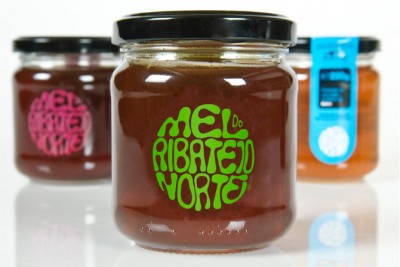Description: The Mel do Ribatejo Norte PDO honey is produced by the Apis mellifera Iberica species of bee and the nectar from the wild flowers and Mediterranean flora of the Ribatejo region. Mel do Ribatejo Norte PDO honey comes in four varieties depending on the largest percentage of pollen type it contains: Serra d'Aire (rosemary, lavender and mint pollen); Albufeira do Castelo do Bode (heather, myrtle and chestnut pollen); Bairro (thistle, rubus, echio and trefoil pollen); Alto Nabão (principally eucalyptus pollen).
Production method: No artificial feeding of the bees is permitted. The honey must be extracted between July and September and must be carried out with the compressed air method or the traditional combing method without the use of repellents. Extraction and filtering must be carried out in the production area itself at a temperature that should not exceed 45°C at any stage.
Special features: Mel do Ribatejo Norte PDO honey is made in four varieties that vary in aroma from strongly perfumed to the delicate perfume of wild flowers. The colour varies but is predominantly pale yellow.
Production area: Mel do Ribatejo Norte PDO is made in the municipal areas of Alcanena, Ourém, Ferreira do Zêzere, Tomar, Vila Nova de Barquinha and Torres Novas, in the district of Santarém.
History: Testimonies of the presence of bee keeping in the Mel do Ribatejo Norte PDO production area date back to at least the 12th century. In fact, in 1178, Dom João Domingues, Master of the Order of the Templars of the Convento di Tomar gave the use of the land round Carvalhal de Cêras to the local inhabitants in exchange for an annual payment of a quarter of their production of olive oil, wine, honey and bees wax. Also, the fresco of Saint Ambrose, the patron saint of bee keepers, in the Capela Secular da Senhora da Conceiçao of Ourém, includes a beehive to represent what the saint usually exhorted his followers to do: "to be as sweet as honey". Lastly, many local place names derive from the making of honey, such as Cêras, Carvalhal de Cêras and Vale das Abelhas.
Caderno de especificações (pdf)
Producer group
Associação de Apicultores da Região de Leiria
Control and certification body
Kiwa Sativa – Unipessoal, Lda.
Control plan
Control plan (pdf)
Publication in EU official journal
Retificação ao Regulamento (CE) n.º 1107/96 da Comissão – L290 13.11.1996
Regulamento (CE) N.º 1107/96 da Comissão de 12.06.1996 – L 148/1
Publication in the Portuguese official journal
Aviso (extrato) n.º 4538/2014, de 25.03.2014
Aviso n.º 23603/2011, de 29.11.2011
Despacho n.º 51/94, de 03.02.1994



